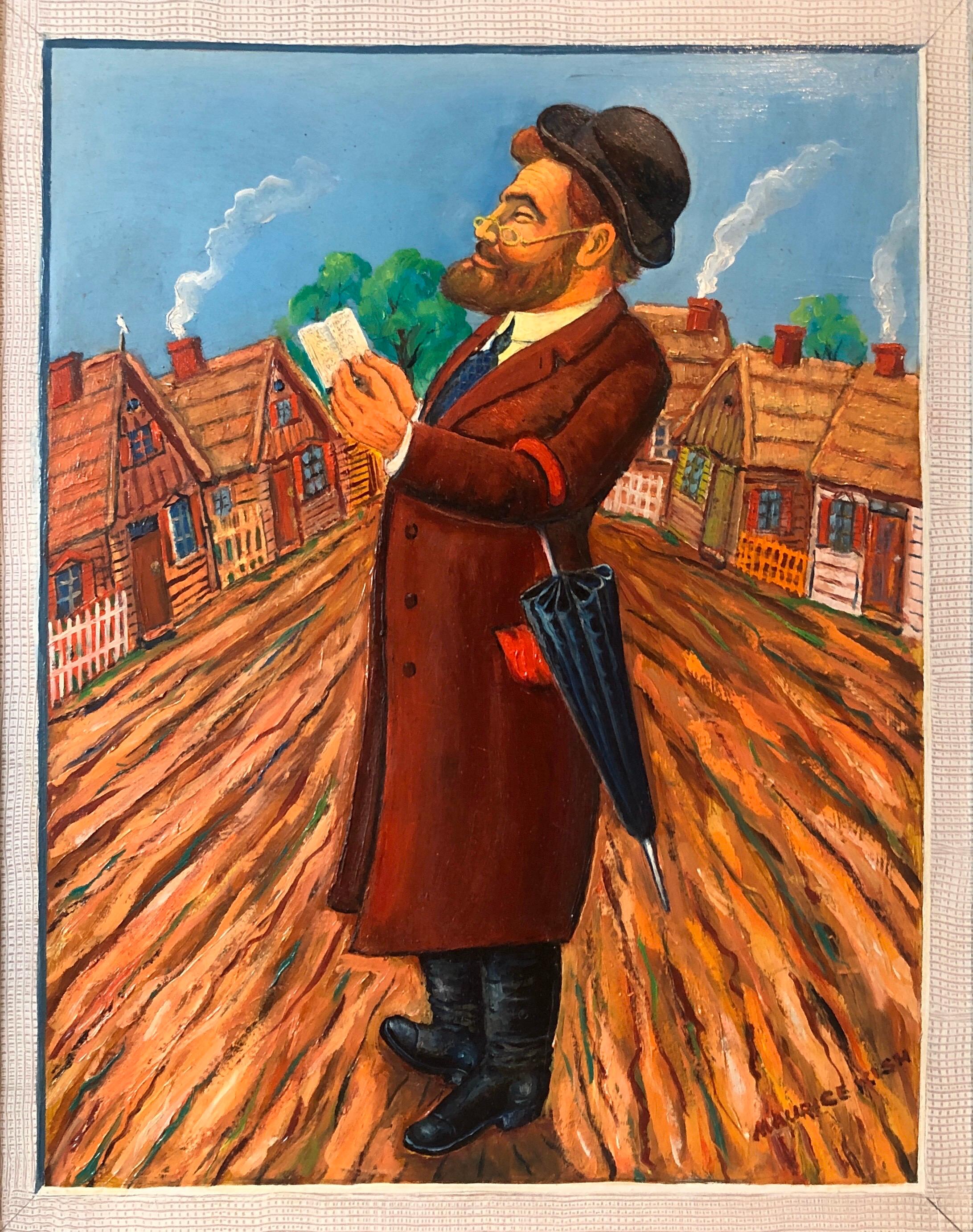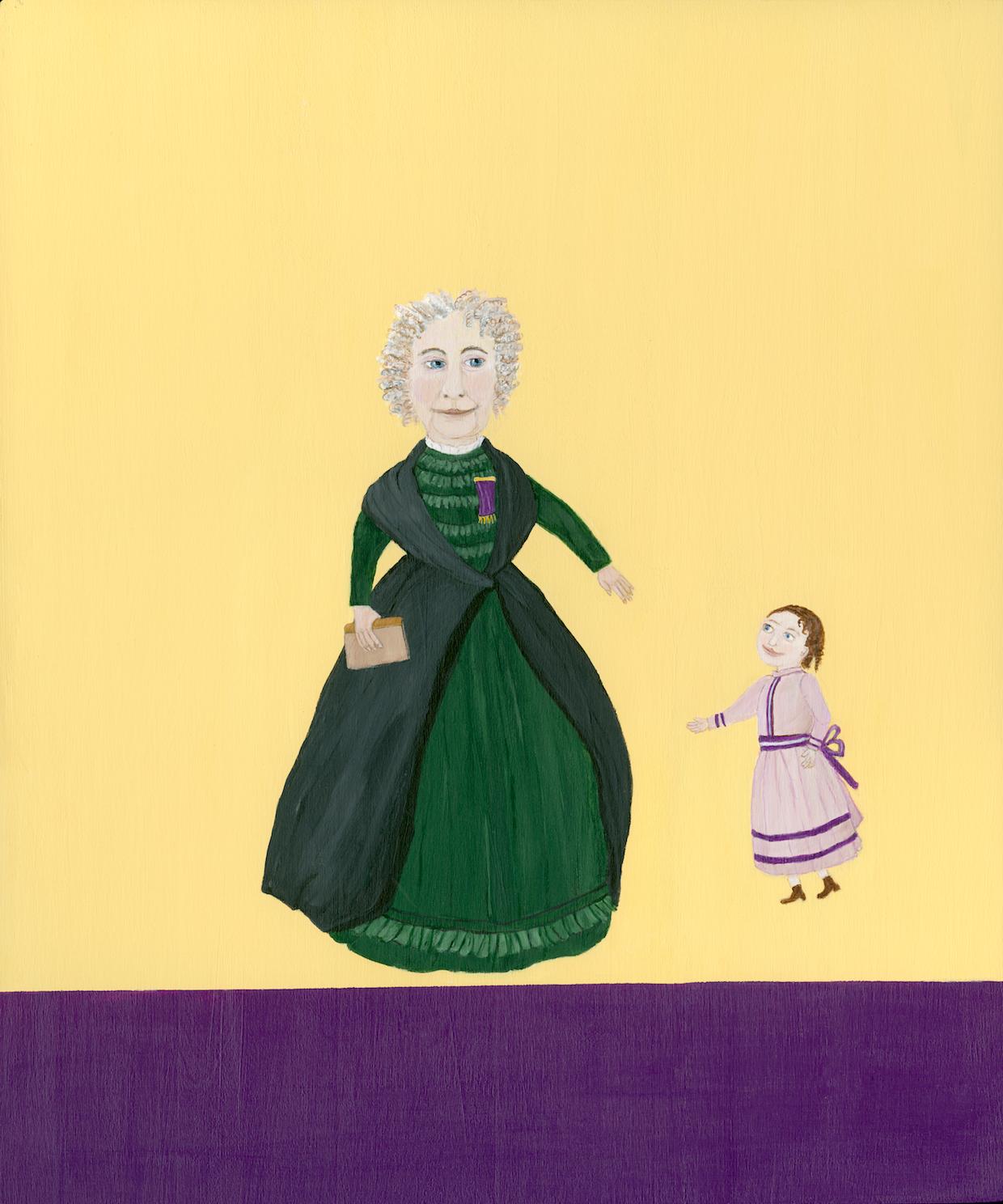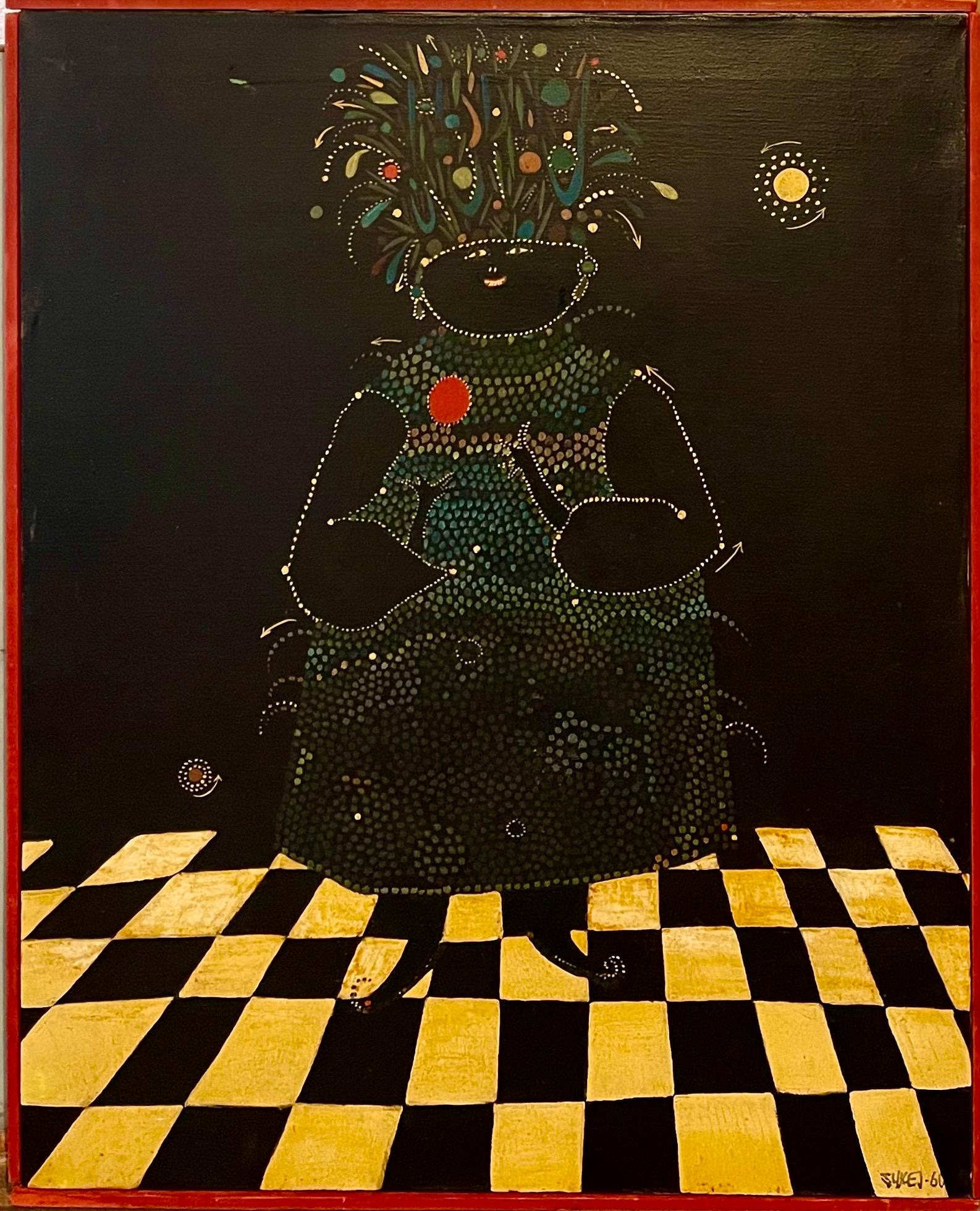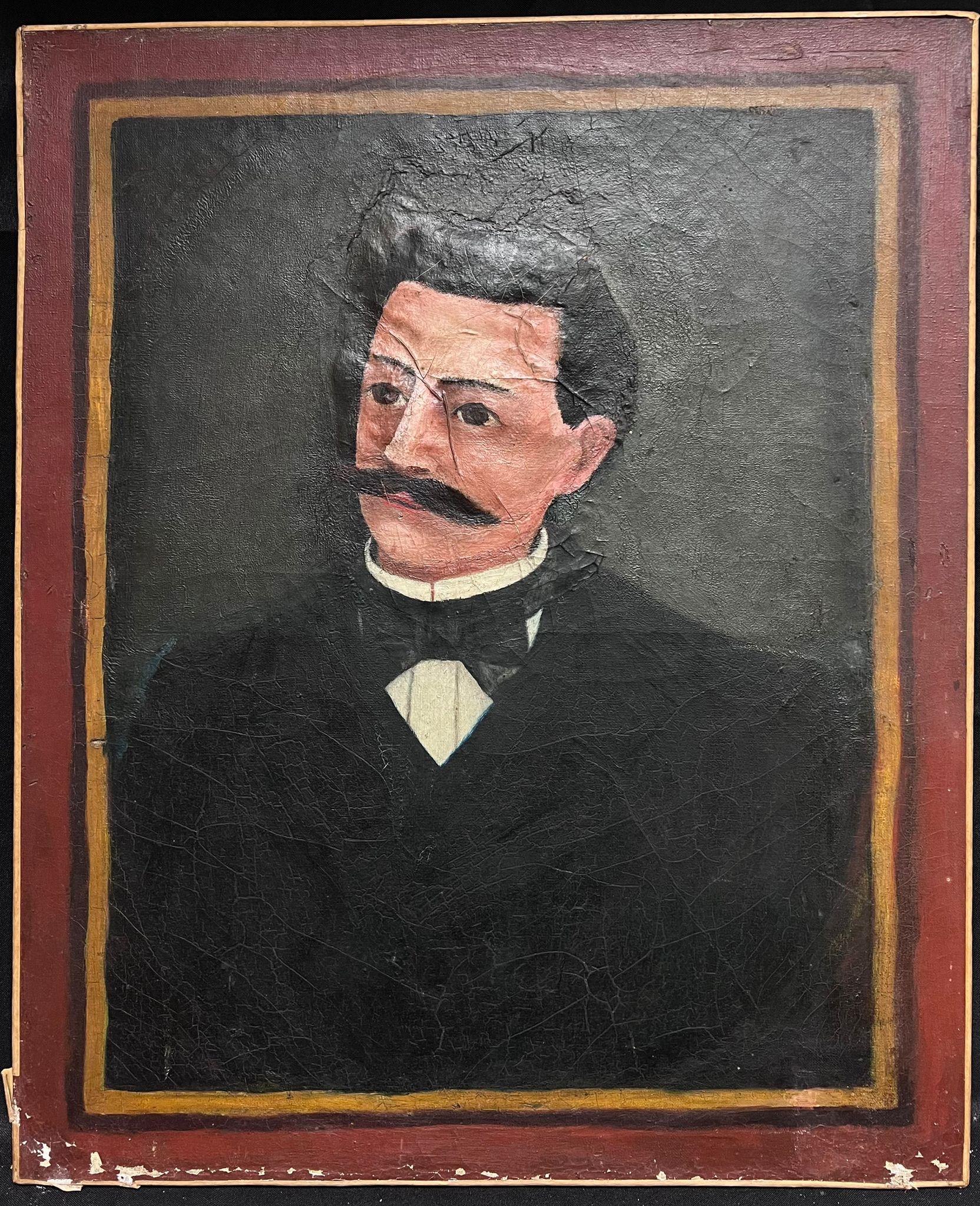Items Similar to Large Malcah Zeldis Folk Art Oil Painting Jazz Great "Satchmo" Louis Armstrong
Want more images or videos?
Request additional images or videos from the seller
1 of 15
Malcah ZeldisLarge Malcah Zeldis Folk Art Oil Painting Jazz Great "Satchmo" Louis Armstrong 1974
1974
About the Item
Swing Jazz Quartet. Satchmo, Louis Armstrong!
Oil Painting on board. Hand signed and dated 1974
Malcah Zeldis (born Mildred Brightman; 1931) is an American folk art painter. She is known for work that draws from a mix of biblical, historical, and autobiographical themes. She is one of the leading self-taught contemporary artists, best known for her paintings depicting urban life, historical and religious events, her heroes, and her own life. Her paintings have been widely exhibited. Her work is in the collection of the Smithsonian American Art Museum and was used for the invitation and posters for the traveling exhibition: American Art on the Move which toured museums during 2001. Of special note is the one-person show presented by the Museum of American Folk Art at New York University in 1988. It was the first time the museum had presented a one-person exhibition of the work of a living folk artist.
Malcah Zeldis was born in the Bronx, New York, and raised in a Jewish ghetto in Detroit, Michigan. Her father faced work discrimination for his religion and the family was poor, but eventually moved to a middle-class neighborhood. However, Zeldis looks back on her years in Detroit fondly, stating that what she remembers best is the nature. She also remembers weekend visits to the Detroit Institute of Arts where she recalls being taken by brightly colored Flemish paintings full of small figures. These paintings would later inspire her colorful works with many small figures.
As a non-devout Jew, Zeldis felt disconnected from her people and wanted to explore her heritage. She moved to Israel in 1949 at the age of eighteen, becoming a Zionist and working on a kibbutz. It was here that Zeldis met her future husband, Hiram Zeldis. The two went back to the US to marry, and then returned to the kibbutz. Zeldis began painting, yet had little confidence in the quality of her work. However, Aaron Giladi, a well known Israeli artist visited the kibbutz and praised Zeldis’s paintings. His suggestion to paint larger intimidated Zeldis. After trying and failing to use larger canvases she stopped painting for a period of time, which was extended by childbirth and a permanent move to Brooklyn, New York. Zeldis finally resumed painting twenty-three years later, as her children grew older and her marriage ended. She enrolled in Brooklyn College as an Early Childhood Studies major in 1970. The college had a "life experience" policy, which prompted Zeldis to submit her paintings despite continued apprehension over whether they were good enough. Much to her surprise, Zeldis's paintings were well received and her teacher introduced her work to an art critic, who further suggested showing her work to dealers. This period was a turning point for Zeldis, as she realized that her lack of training was not a barrier to the art world. It was around this time that she observed Haitian folk art in a gallery. She found Haitian folk art very stylistically similar to her own, and finally believed that she was an artist. Zeldis began painting seriously and had a number of gallery shows. Her work also appeared in books such as the International Dictionary of Naive Art and Moments in Jewish Life: The Folk Art of Malcah Zeldis. Zeldis later worked in children's book illustration in collaboration with her daughter, Yona Zeldis. Her naive, whimsical images contain a number of storytelling devices and attempt to convey a narrative.
Louis Armstrong (1901 – 1971), nicknamed "Satchmo", "Satch", and "Pops", was an American trumpeter and vocalist. He is among the most influential figures in jazz. His career spanned five decades and different eras in the history of jazz.
Armstrong was born and raised in New Orleans. Coming to prominence in the 1920s as an inventive trumpet and cornet player, Armstrong was a foundational influence in jazz, shifting the focus of the music from collective improvisation to solo performance. Around 1922, he followed his mentor, Joe "King" Oliver, to Chicago to play in the Creole Jazz Band. In Chicago, he spent time with other popular jazz musicians, reconnecting with his friend Bix Beiderbecke and spending time with Hoagy Carmichael and Lil Hardin. He had a famous recording of Go Down Moses on an album of gospel music, African-American religious folk songs known as Negro spirituals. He earned a reputation at "cutting contests" and his fame reached band leader Fletcher Henderson. Hardin became Armstrong's second wife and they returned to Chicago to play together and then he began to form his own "Hot" jazz bands. After years of touring, he settled in Queens, and by the 1950s, he was a national musical icon, assisted in part, by his appearances on radio and in film and television, in addition to his scat singing and concerts. By the end of Armstrong's life, his influence had spread to popular music in general. Armstrong was one of the first popular African-American entertainers to "cross over" to wide popularity with white (and international) audiences. He rarely publicly politicized his race, to the dismay of fellow African Americans, but took a well-publicized stand for desegregation in the Little Rock crisis. He was able to access the upper echelons of American society at a time when this was difficult for black men. Armstrong appeared in films such as High Society (1956) alongside Bing Crosby, Grace Kelly, and Frank Sinatra, and Hello, Dolly! (1969) starring Barbra Streisand. He received many accolades including three Grammy Award nominations and a win for his vocal performance of Hello, Dolly! in 1964. In 2017, he was posthumously inducted into the Rhythm & Blues Hall of Fame.
Zeldis is also fond of biblical themes. Israel, and the larger Jewish world, have had a Vibrant Folk Art, Naive art scene for a long time now, artists like Yisrael Paldi, Nahum Guttman, Reuven Rubin and even Yefim Ladyzhensky had naive periods. The most well know of the strict naive artists are Shalom of Safed, Irene Awret, Gabriel Cohen, Natan Heber, Michael Falk and Kopel Gurwin. Malka Zeldis and her daughter have written and illustrated Eve and Her Sisters: Women of the Old Testament, God Sent a Rainbow and Other Bible Stories, Anne Frank, Sisters in Strength: American Women Who Made a Difference, and Hammerin' Hank. Malcah Zeldis has also illustrated Honest Abe (President Abraham Lincoln) and African American civil rights icon Martin Luther King.
She earned her Bachelor’s degree at Brooklyn College, New York in 1970. She has exhibited her works at American Visionary Art Museum, Baltimore, Maryland; Wright Museum of African American History, Detroit, Michigan; The Bass Museum of Fine Art, Miami Beach, FL, Frederick Weisman Art Museum, MI; Brooks Museum of Art, Memphis, TN; Montgomery Museum of Fine Arts, Montgomery, AL; Andrew Edlin Gallery, New York; Tampa Museum of Art, Tampa, FL; Katonah Museum of Art, Katonah, NY; Terra Museum of Art, Chicago, IL; Stedman Art Gallery, Rutgers University, New Brunswick, NJ; Creative Heart Gallery, Winston-Salem, NC; Modern Primitive Gallery, Atlanta, GA; New Orleans Museum of Art, New Orleans, LA; Jay Johnson Gallery, New York, NY; and the Phyllis Kind Gallery, Chicago, IL. Her work is in the permanent collections of museums such as Abby Aldrich Rockefeller Museum, Williamsburg, VA; Akron Museum, Akron, OH; International Folk Art Museum, Santa Fe, NM; Jane Voorhees Zimmerli Museum, Rutgers Collection of Children’s Literature, New Brunswick, NJ; Jewish Museum, New York, NY; John Judson Memorial American Museum, Washington, DC; Milwaukee Museum of Art, Milwaukee, WI; May Museum of Art, Lawrence NY; The Museum, Kresge Art Gallery, Michigan State University, East Lansing, MI; Musée D'Art Naif De Lille de France, Paris, France; The American Folk Art Museum, New York, NY; Noyes Museum, Oceanville, NJ; St. Louis Mid-American Arts Alliance (Mulvane Art Center), St. Louis, MO; Skirball Cultural Center, Los Angeles, CA; Smithsonian Institute, Washington DC; and the Yeshiva University Museum, New York, NY.
PUBLIC COLLECTIONS
Abby Aldrich Rockefeller Museum, Williamsburg, VA
Akron Museum, Akron, OH
International Folk Art Museum, Santa Fe, NM
Jane Voorhees Zimmerli Museum, Rutgers Collection of Children’s Literature, New Brunswick, NJ
Jewish Museum, New York, NY
John Judson Memorial American Museum, Bath, England
Klutznick National Jewish Museum, Washington, DC
Milwaukee Museum of Art, Milwaukee, WI
May Museum of Art, Lawrence, NY
Kresge Art Center Gallery, Michigan State University, East Lansing, MI
Musée d’Art Naïf – Max Fourny, Paris, France
The American Folk Art Museum, New York, NY
New York State Historical Association, Cooperstown, NY
Noyes Museum, Oceanville, NJ
Pennsylvania Academy of the Fine Arts Museum, Philadelphia, PA
St. Louis Mid-America Arts Alliance (Mulvane Art Center), St. Louis, MO
Skirball Cultural Center, Los Angeles, CA
Smithsonian Institute, Washington, DC
Yeshiva University Museum, New York, NY
- Creator:Malcah Zeldis (1931)
- Creation Year:1974
- Dimensions:Height: 49 in (124.46 cm)Width: 37 in (93.98 cm)
- Medium:
- Movement & Style:
- Period:
- Condition:good. frame has minor wear.
- Gallery Location:Surfside, FL
- Reference Number:1stDibs: LU3828993382
About the Seller
4.9
Platinum Seller
These expertly vetted sellers are 1stDibs' most experienced sellers and are rated highest by our customers.
Established in 1995
1stDibs seller since 2014
1,550 sales on 1stDibs
Typical response time: 1 hour
- ShippingRetrieving quote...Ships From: Surfside, FL
- Return PolicyA return for this item may be initiated within 3 days of delivery.
More From This SellerView All
- Whimsical Judaica Shtetl Shadchan Matchmaker Oil Painting WPA Jewish Folk ArtistBy Maurice KishLocated in Surfside, FLGenre: Modern Subject: Fiddler on the roof, Shtetl matchmaker Medium: Oil Surface: Board, size includes artist decorated frame Country: United States The imagery of Maurice Kish (1895-1987), whether factories or carousels, reliably subverts expectations. His vision hovers just around the unraveling edge of things, where what is solid and clear becomes ambiguous. He is fascinated, often delighted, by the falling apart. This unexpected, fresh perspective results in oddly affecting pictures of a now long-gone New York. Born Moishe in a town called Dvinsk, Russia (what is now Daugavpils, Latvia), Kish came with his family to New York when he was in his teens. The family settled in Brownsville, and for the rest of Kish’s life Brooklyn remained his home, though he moved from one neighborhood to another. He was close to his parents, who recognized his talent and supported his desire to become an artist. Kish attended the National Academy of Design as well as Cooper Union. His fellow students included many other immigrants and children of immigrants who were particularly receptive to the Modernism coming from Europe. As his career progressed, Kish himself applied different strains of Modernism to different purposes. For him, the story was held above all else. For years, Kish used the skills he acquired in art school to earn his living at a Manhattan glass...Category
Mid-20th Century Folk Art Figurative Paintings
MaterialsBoard, Oil
- Alabama Surreal Folk Art Oil Painting African American Woman, Flower HeaddressBy Maltby SykesLocated in Surfside, FLThe painting is signed Sykes and dated 1960 lower right. It has "Maltby Sykes, 1911- for Leon" written on the stretcher verso It is a Surrealist Folk Art ...Category
1960s Folk Art Figurative Paintings
MaterialsCanvas, Oil
- Malcah Zeldis Folk Art Gouache Moses Bible Painting Self Taught Outsider ArtistLocated in Surfside, FLMALCAH ZELDIS (American-Israeli, b. 1931) Moses and the burning bush, 1982, gouache on paper, Hand signed and dated lower middle. Paper 9''h, 11-3/4''w...Category
1980s Folk Art Figurative Paintings
MaterialsPaper, Gouache
- Malcah Zeldis Folk Art Gouache Painting King David Self Taught Outsider ArtistLocated in Surfside, FLMALCAH ZELDIS (American-Israeli, b. 1931), ''David and Saul'', 1982, Gouache on paper Hand signed and dated lower right, titled in pencil on paper verso...Category
1980s Folk Art Figurative Paintings
MaterialsPaper, Gouache
- Malcah Zeldis Folk Art Gouache Painting Outsider Artist Circus Fire Eater, TigerLocated in Surfside, FLMALCAH ZELDIS ''Circus, Fire Eaters'', 1989, gouache on paper Hand signed and dated bottom center, titled in pencil on paper verso Paper 12''h, 9''w. Provenance: Estate of Laura Fisher...Category
1980s Folk Art Figurative Paintings
MaterialsPaper, Gouache
- Outsider Folk Art Expressionist Rabbi Israeli Painting Signed Hebrew Jewish StarLocated in Surfside, FLThis is a signed portrait painting done in an outsider, folk art, expressionist style. it is signed in Hebrew, also marked with a Jewish star. this is from a collection of works by the same hand. they are all signed. Some have markings to the back of the paper. they have some age to them. They bear similarities to artists as dissimilar as Moshe Tamir, Mane Katz and an Israeli version of Purvis Young. In this piece the artist choice of colors is muted yet powerful. Israel has had a Vibrant Folk Art, Naive art scene for a long time now, artists like Yisrael Paldi, Nahum Guttman, Reuven Rubin and even Yefim Ladyzhensky had naive periods. The most well know of the strict naive artists are Shalom of Safed, Irene Awret, Gabriel Cohen, Natan Heber, Michael Falk and Kopel Gurwin. Naïve art is any form of visual art that is created by a person who lacks the formal education and training that a professional artist undergoes (in anatomy, art history, technique, perspective, ways of seeing). Unlike folk art, naïve art does not necessarily evince a distinct cultural context or tradition. Naïve art is recognized, and often imitated, for its childlike simplicity and frankness. Paintings of this kind typically have a flat rendering style with a rudimentary expression of perspective. One particularly influential painter of "naïve art" was Henri Rousseau (1844–1910), a French Post-Impressionist who was discovered by Pablo Picasso. Naïve art is often seen as outsider art that is by someone without formal (or little) training or degree. While this was true before the twentieth century, there are now academies for naïve art. Naïve art is now a fully recognized art genre, represented in art galleries worldwide. Museums devoted to naïve art now exist in Kecskemét, Hungary; Riga, Latvia; Jaen, Spain; Rio de Janeiro, Brasil; Vicq France and Paris. "Primitive art" is another term often applied to art by those without formal training, but is historically more often applied to work from certain cultures that have been judged socially or technologically "primitive" by Western academia, such as Native American, sub saharan African or Pacific Island art (see Tribal art). This is distinguished from the self-conscious, "primitive" inspired movement primitivism. Another term related to (but not completely synonymous with) naïve art is folk art. There also exist the terms "naïvism" and "primitivism" which are usually applied to professional painters working in the style of naïve art (like Paul Gauguin, Mikhail Larionov, Paul Klee). At all events, naive art can be regarded as having occupied an "official" position in the annals of twentieth-century art since - at the very latest - the publication of the Der Blaue Reiter, an almanac in 1912. Wassily Kandinsky and Franz Marc, who brought out the almanac, presented 6 reproductions of paintings by le Douanier' Rousseau (Henri Rousseau), comparing them with other pictorial examples. However, most experts agree that the year that naive art was "discovered" was 1885, when the painter Paul Signac became aware of the talents of Henri Rousseau and set about organizing exhibitions of his work in a number of prestigious galleries. The Earth Group (Grupa Zemlja) were Croatian artists, architects and intellectuals active in Zagreb from 1929 to 1935. The group included the painters Krsto Hegedušić, Edo Kovačević, Omer Mujadžić, Kamilo Ružička, Ivan Tabaković, and Oton Postružnik, the sculptors Antun Augustinčić, Frano Kršinić, and the architect Drago Ibler. Art brut, primitive art, primitive, art naïf, naïve art. Outsider art. A term applied to Yugoslav (Croatian) naive painters working in or around the village of Hlebine, near the Hungarian border, from about 1930. Some of the best known naive artists are Dragan Gaži, Ivan Generalić, Josip Generalić, Krsto Hegedušić, Mijo Kovačić, Ivan Lacković-Croata, Franjo Mraz, Ivan Večenaj and Mirko Virius. Camille Bombois (1883–1970) Ferdinand Cheval, known as 'le facteur Cheval' (1836–1924) Henry Darger (1892–1973) L. S. Lowry (1887–1976) Grandma Moses, Anna Mary Robertson (1860–1961) Nikifor (1895–1968) Poland, Horace Pippin (1888–1946) Jon Serl (1894-1993) United States Alfred Wallis (1855–1942) Scottie Wilson (1890–1972) Gesner Abelard (b. 1922) Jan Balet (1913–2009) Michel Delacroix (b. 1933) France Howard Finster (1916–2001) Ivan Rabuzin (1921–2008) Spontaneous Art Museum in Brussels Art en Marge Museum in Brussels MADmusée in Liege International Museum of Naive Art of Brazil in Cosme Velho, Rio de Janeiro Gallery Jacques Ardies in São Paulo Musée international d'art naïf de Magog in Magog Croatian Museum of Naïve Art in Zagreb Gallery of Croatian Naïve Art...Category
20th Century Outsider Art Portrait Paintings
MaterialsGouache
You May Also Like
- Mid Century Pulp Art - Sad Clown Portrait with Green, Yellow, & RedLocated in Soquel, CAMid century pulp art portrait of a somber clown with a yellow shirt, red hair and a red nose, holding a scepter in a dramatized space with a candle and green ...Category
1960s Outsider Art Portrait Paintings
MaterialsCanvas, Acrylic, Cardboard
- Mary Dwyer, Elizabeth Cady Stanton_Seneca Falls 1870s_2014_acrylic on board,By Mary DwyerLocated in Darien, CTThese new paintings illuminate individuals of the American Suffrage Movement. Elizabeth Cady Stanton, Ida B Wells and Alice Paul, each one intelligent, brave and incredibly relentless in the struggle to attain voting rights for American women. This series of paintings portrays the ardent women involved in the American Suffrage Movement which led up to the 19th Amendment...Category
2010s Folk Art Portrait Paintings
MaterialsBoard, Acrylic
- Tuscan Historical Figurative painting 20th century oil on canvasLocated in Florence, ITThe artist of this painting is unknown, but it is a direct derivation of "The Stagecoach of the Grand Duke" by Raffaello Sorbi, now held in a private collection in Milan, as we can s...Category
20th Century Folk Art Figurative Paintings
MaterialsCanvas, Oil
- 19th Century French Naive Portrait of Gentleman with Moustache Oil PaintingLocated in Cirencester, GloucestershirePortrait of a Gentleman French School, 19th century circle of Henri Rousseau, 1844 - 1910 oil on canvas, unframed canvas: 24 x 20 inches provenance: private collection, France condit...Category
19th Century Folk Art Figurative Paintings
MaterialsOil
- 19th Century French Naive Portrait of Lady Large Oil Painting on CanvasBy Henri RousseauLocated in Cirencester, GloucestershirePortrait of a Lady French School, 19th century circle of Henri Rousseau, French 1844 - 1910 oil on canvas, unframed canvas: 24 x 23.5 inches provenance: private collection, France co...Category
19th Century Folk Art Figurative Paintings
MaterialsOil, Canvas
- Voodoo Devils Take the Sick - The Fight of Good vs Evil - VodouBy Wilson BigaudLocated in Miami, FLDevils depicted. Artist Wilson Bigaud paints a graphic narrative of mid-century life in Haiti without modern medicine. A man is dying yet there is no doctor present. In the struggle...Category
1950s Outsider Art Figurative Paintings
MaterialsMasonite, Oil
Recently Viewed
View AllMore Ways To Browse
Religion Art
Vintage Future Art
Pop Art Musicians
1950s Paintings Large
Retro Future Art
Middle East Art
East African Art
Vintage Jazz Art
Large Art Exhibition Poster
Vintage Art Collective
Bible Art
Childrens Art Posters
Music Tv Art
Singing Art
1920s Paris France Paintings
Biblical Art
Sisters Modern Art
Frederick The Great





